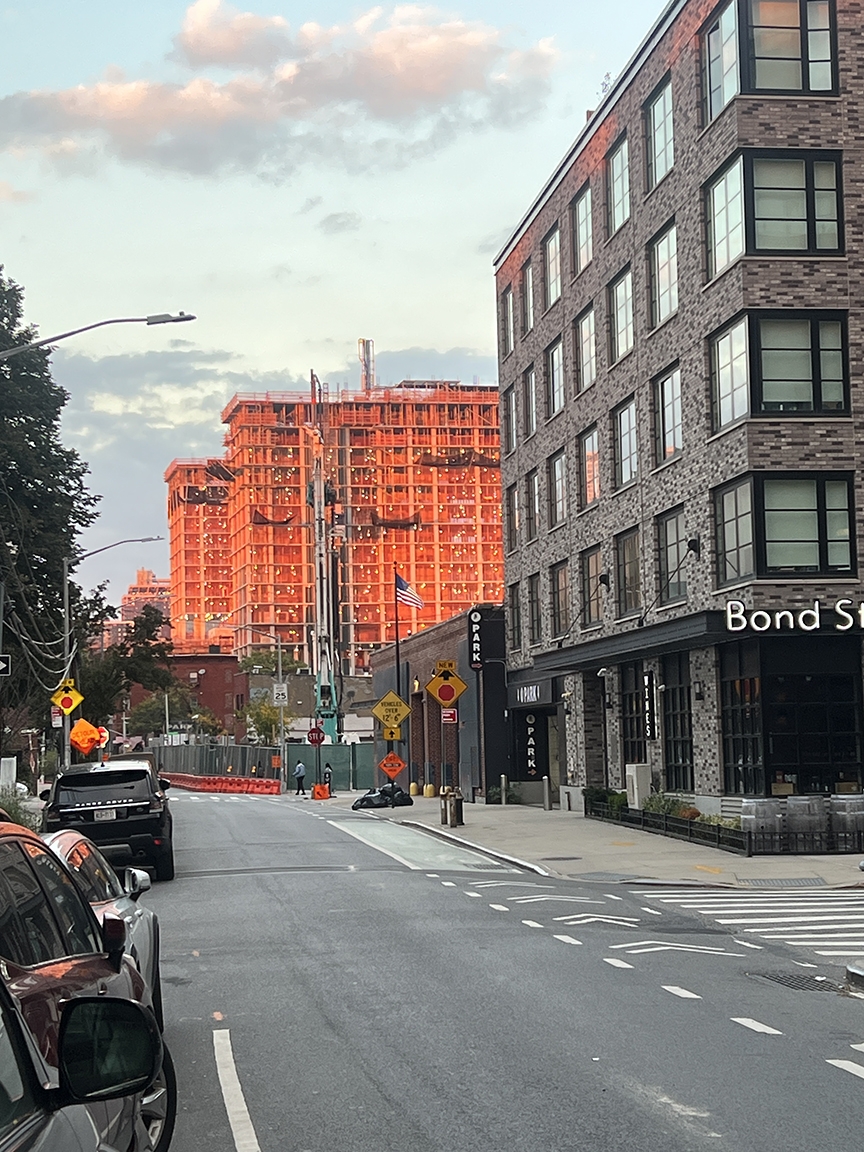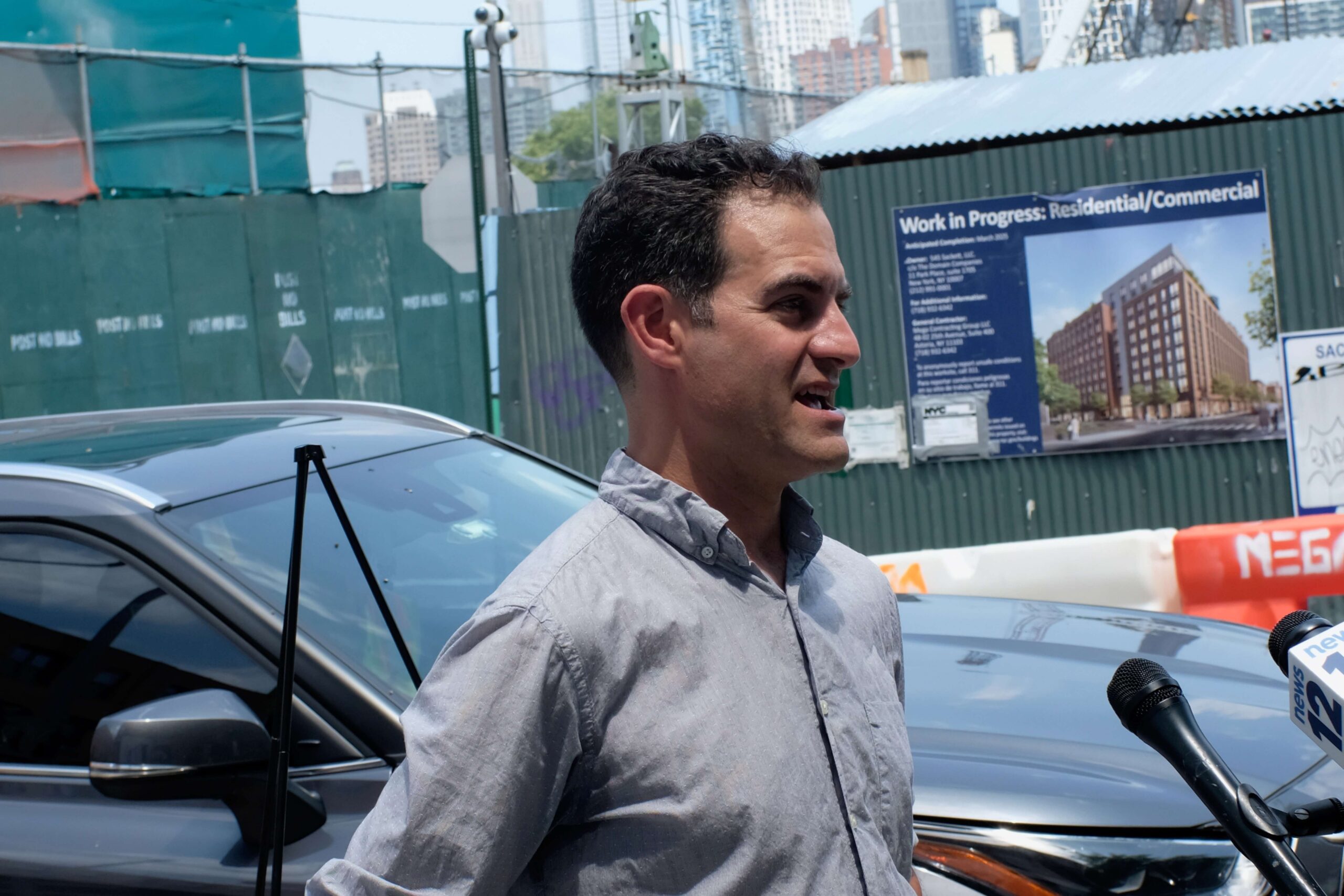(Editor’s note – Mr. Hang takes issue with our characterization of these events, and requested that we include his clarification: “Please note that we have NOT called for a “moratorium on new construction” in the Gowanus Canal Area. We respectfully wrote Governor Hochul: “Until the shortcomings of New York’s Brownfield program have been fully assessed and all applicable regulatory cleanup requirements are strictly enforced, we request that you require DEC and DOH to halt approvals for Brownfield toxic site developments. We also request that earlier Brownfield approvals be required to fulfill all applicable regulatory requirements.”
The community advocacy group Voice of Gowanus and Toxics Targeting, an Ithaca-based environmental data firm that tracks contaminated sites in New York state, are calling on Governor Kathy Hochul to put a pause on new construction on brownfield sites before all contamination is comprehensively cleaned up. The call comes after Toxics Targeting uncovered that the New York State Department of Environmental Conservation had found elevated levels of trichloroethylene, an industrial chemical linked to cancer and Parkinson’s disease, in the indoor air of several buildings along the canal.
On June 17, Voice of Gowanus and Toxics Targeting called a press conference to announce their latest findings and renew their calls for the state to investigate soil vapor intrusions in all structures within 1,000 feet of a brownfield or inactive hazardous waste site in New York and to remove any toxic waste found.
“I believe this is an unprecedented discovery of how soil vapor intrusion can pose a public health hazard,” said Walter Hang, president and founder of Toxics Targeting, in front of a small group of reporters and community members who had gathered for the press conference. “These are brownfields that have never been comprehensively investigated or remediated.”
A brownfield site is land where contamination due to prior industrial use complicates or prevents full utilization of the land. Brownfields are remediated through the Brownfield Cleanup Program, which is a voluntary program that offers incentives to developers who agree to clean up properties so that they can be built on.
Highly volatile solvent
Historically, Gowanus was home to a variety of industries. It was common for these industries to use trichloroethylene, a common industrial solvent also known as TCE, for degreasing operations. TCE is highly volatile, meaning that if it sits in soil or groundwater, “it readily evaporates and gets into the air even at room temperature,” said Dr. Paige Lawrence, professor and chair of the Department of Environmental Medicine at the University of Rochester.
In Gowanus, this means that from the contaminated soil and groundwater, TCE is now evaporating into buildings that sit on or around the neighborhood’s brownfields.
The adverse health effects of TCE have been known for nearly a century. Exposure to the chemical, which can occur through breathing, has been strongly linked to certain types of cancers — kidney and liver cancer and non-Hodgkin’s Lymphoma — as well as autoimmune disorders, according to Dr. Lawrence.
Further, she said, “There have been, especially in animal models, but also in some human epidemiological studies, some associations between exposure to TCE and neurodegenerative diseases like Parkinson’s disease.”
The connection between TCE exposure and neurodegenerative diseases has been explored since the middle of the 20th century. One study on 99 twin pairs from 2012, for example, showed that the twin that experienced occupational or hobby exposure to TCE saw a 500% increased risk of developing Parkinson’s disease later in life. (The study also noted that it takes between 10 and 40 years after exposure for symptoms to develop.)
Even low exposure might hurt
However, the extent to which TCE exposure causes Parkinson’s disease is not fully known. A cause-and-effect relationship is difficult to study, as symptoms can show up many years after exposure. Another recent research study showed that breathing in even low amounts of TCE caused significant loss of dopamine-producing neurons in rodents and also affected motor coordination.
“There’s also evidence showing that other types of environmental exposures have also been associated with Parkinson’s disease. I think the complexity there is when we say Parkinson’s disease, we have one name, but many different pathways can lead to the symptoms of Parkinson’s disease,” said Dr. Lawrence. “Consequently, different environmental exposures, in different people, could increase risk of developing Parkinson’s disease.”
The DEC has investigated soil vapor intrusions in Gowanus for years, but the department’s work has grown significantly in the past three years following some alarming discoveries. In March 2021, trichloroethylene levels 10,000 times the New York State Health Department’s guidelines — two micrograms per cubic meter — were found under the Royal Palms Shuffleboard Club on 514 Union St. The air inside the club had a concentration 20 times the limit recommended by the state health department.
Since the initial investigation and remediation of airborne trichloroethylene at 514 Union St. (tests on May 16, 2024, showed levels below state limits, according to DEC), other buildings in the vicinity have been investigated by the DEC for soil vapor intrusions.
One building, which the DEC cannot name publicly due to privacy policies but is believed to be 543 Union St., was found to have 900 micrograms of trichloroethylene per cubic meter of air in the basement — 450 times the state’s limit — in February 2023. Levels remained significantly above acceptable levels for the first six months of 2023, but no data has been shared indicating the building’s current levels.
In September 2023 the DEC launched an expanded investigation into soil vapor intrusion in all of Gowanus. The first phase of the investigation focused on properties near the top and along the west side of the canal, and so far, 100 properties have been sampled.
However, as it is voluntary for property owners to allow the environmental conservation department access to their buildings, it is impossible to say if all buildings within the study area for the vapor intrusion investigation will ever be tested.
This is not good enough for Voice of Gowanus and Toxics Targeting, who want the state to compel the potentially responsible parties — people, businesses, government entities or anyone else responsible for contaminating a site in the first place — to conduct testing of all properties within 1,000 feet of a contaminated site.
“If landlords don’t want their property investigated for trichloroethylene, you have to go get a court order and you’ve got to go in and monitor the air to protect the community,” said Hang.
In an email to the Star-Revue, DEC writes that the study “allows the state to identify and eliminate unacceptable public exposures to contamination, while also identifying where contamination exists, and which parties may be responsible for contamination,” adding, “The state will not wait until those parties are known before taking action to address exposures.”
It varies how the state can address exposure to toxic vapors and the underlying contamination from where the vapors originate. Its remedies, the DEC writes, include removing or treating the contaminants where possible and containing them to keep them from migrating to other properties. All cleanup efforts aim to restore the site to what it was like before it was contaminated. But that is not always possible, according to DEC.
“Achieving pre-disposal conditions, especially in areas of the state that were subject to centuries of industrial development, is often infeasible. For example, areas where existing homes or businesses are present may prevent achieving pre-disposal conditions unless residents and business owners were willing to be permanently displaced,” the agency writes.
If pre-disposal conditions can’t be achieved but the contamination still poses a health risk, the DEC continues, “DEC and DOH (Department of Health) will require a suite of effective long-term controls to prevent potential exposure to remaining contamination to help ensure building occupants and the public at large are protected.”
However, some are critical of how the DEC views its responsibility to protect public health in areas on and around contaminated sites.

“When you’re building new buildings, you have to think long-term, 100 years from now. What we need to be doing is digging it up and getting it out of the ground so that it doesn’t continue to evaporate into our buildings. And that’s not happening,” said Seth Hillinger, a member of Voice of Gowanus who’s lived in the neighborhood for 20 years. “This isn’t just about today; it’s about tomorrow and into the future.”
As more and more land in Gowanus is being built on, the state has also received criticism for allowing new construction on and near brownfield sites, including a building that will contain 654 apartments — of which 154 units will be affordable — on a brownfield site along Nevins street. The 318 Nevins St. project is in a brownfield cleanup program, meaning that developers “must address contamination in soil, groundwater, and soil vapor based on the future planned affordable housing at the site, and DEC will not deem the cleanup complete until contamination has been addressed,” the agency writes to the Star-Revue. How the contamination will be addressed is yet to be determined, however.
It’s common sense, said Hillinger, to not build on contaminated land, and argued against solutions like putting down a cap to isolate the contaminants and keeping it from migrating — which could be an acceptable solution under New York state law if completely removing the contaminants is not feasible — fearing that rising and falling groundwater will still carry toxic chemicals with it to other properties.
“The state solution is not a comprehensive, effective solution to protect the whole community,” Hillinger said.
Author
-

I’m a New York-based journalist from Sweden. I write about the environment, how climate change impacts us humans, and how we are responding.
View all posts
I’m a New York-based journalist from Sweden. I write about the environment, how climate change impacts us humans, and how we are responding.











5 Comments
My experience has been that Toxics Targeting often exaggerates and overstates environmental risks. It is an environmental data base looking for a purpose.
Lawrence, shocking to learn that you work for Big Real Estate to help them put people on toxic land and “minimize their potential liability.” You’re just an upstanding citizen who cares about our community, right? I don’t think so… Anyone interested in what he’s really about, check out: https://www.environmental-law.net
i also believe that the DEC does not have legal grounds for not disclosing the other properties with vapor issues. The names of individuals can be easily redacted but this is a public health issue. News organization should sue the agency for this information.
BTW- DEC has the authority to issue what is known as a “10-day letter” which required property owners to provide access for sampling. I have had clients receive such orders to investigate vapor intrusion from off-site sources. So the agency does not have to rely on voluntarily cooperation and does not have to hide behind the alleged privacy grounds for keeping the results from the public.
Who’s paying Toxics Targeting? And why haven’t any of these people allegedly terrified about the toxicity of Gowanus moved out of the neighborhood?